
Search
The Renewable Energy site for Do-It-Yourselfers
$2K Solar Space + Water: Backup Heat System
|
This page describes the new backup heating system which provides heat to the solar heat storage tank when there is not enough sun available to do the job.
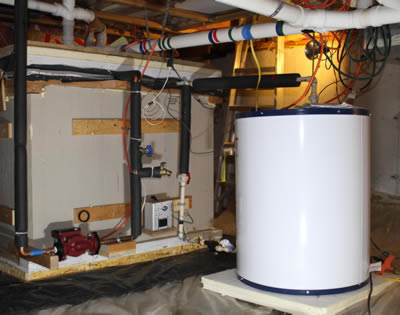
In this backup system a new electric water heater provides heat to the main solar tank when there is not enough sun to keep the main solar tank hot enough for space heating.
|
|
Background
Our house came with two gas furnaces. The smaller of the two furnaces heated our bedroom area and a "bonus" space above the garage. The other furnace heated the main part of the house. Our $2K system heats the same bedroom area using a radiant floor (but not the bonus room). We have another solar heating system that helps with heating the main part of the house.
Last year the gas furnace that does the bedroom part of the house died, and the bill to replace it was $6000. We never did liked the noise and potential safety issues of having the gas furnace hung from the crawl space ceiling right underneath our bed. In addition, we did not like heating the bonus guest bedroom space that very rarely gets used, but it was about half the load on the furnace, and cutting off that much of a furnace's design load is hard on the furnace and may shorten its life.
So, we decided to abandon the gas furnace and instead provide a way to heat the solar heat storage tank when there is not enough sun to do the job. This is quieter and a whole lot cheaper than replacing the furnace. So, on the new system the solar storage tank provides all the heating via the radiant floor loops, and when the solar input is not enough to keep the tank hot enough, the backup system adds heat to the solar tank.
The backup system consists of a 3700 watt electric hot water tank that maintains a temperature around 100F. When the main solar tank temperature falls below a level you set, a pump circulates hot water from the electric hot water tank into the solar tank to warm it up. When the solar tank gets up to temperature, the pump is shut down.
This diagram shows how it works.
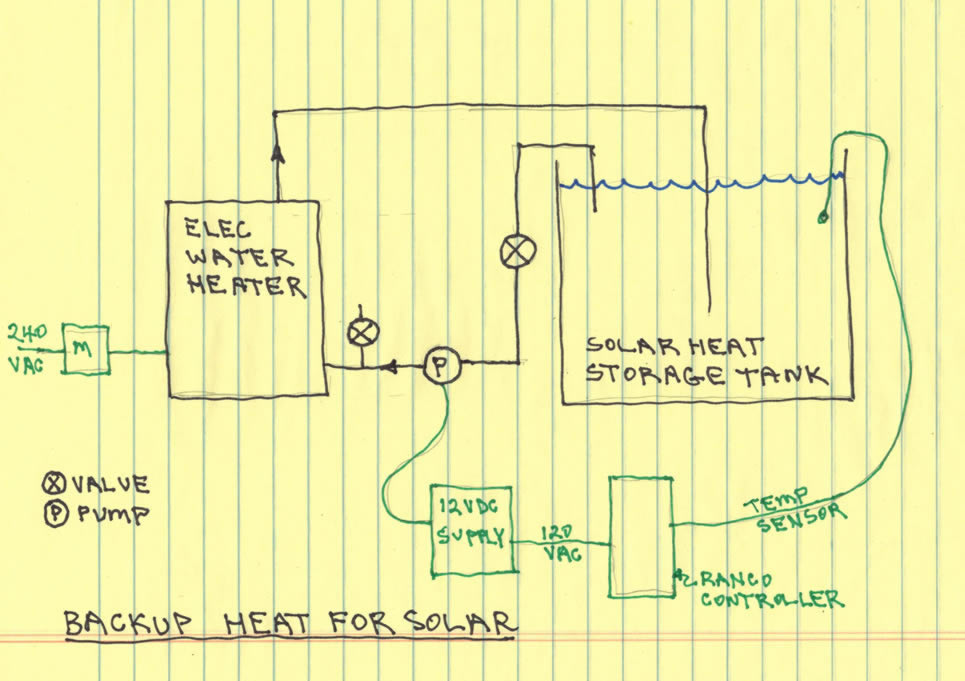
The electric hot water heater is a standard Whirlpool from Lowes for $290. Its a 240VAC water heater with 3700 watt elements (only one of which is on at any give time).
Its about 30 inches tall so that the top of the water heater is below the water line of the solar tank and there won't be any issue with keeping it and the plumbing full. The capacity is about 30 gallons.
One nice thing about this arrangement is that the water heater takes care of itself. It maintains the temperature you dial on on its thermostat and no external controls are needed. For the summer, I will just flip the circuit breaker off.
I was able to convert the #12 wire circuit that used to serve the old furnace to 240VAC, so minimal wiring was required to add the electric heater.
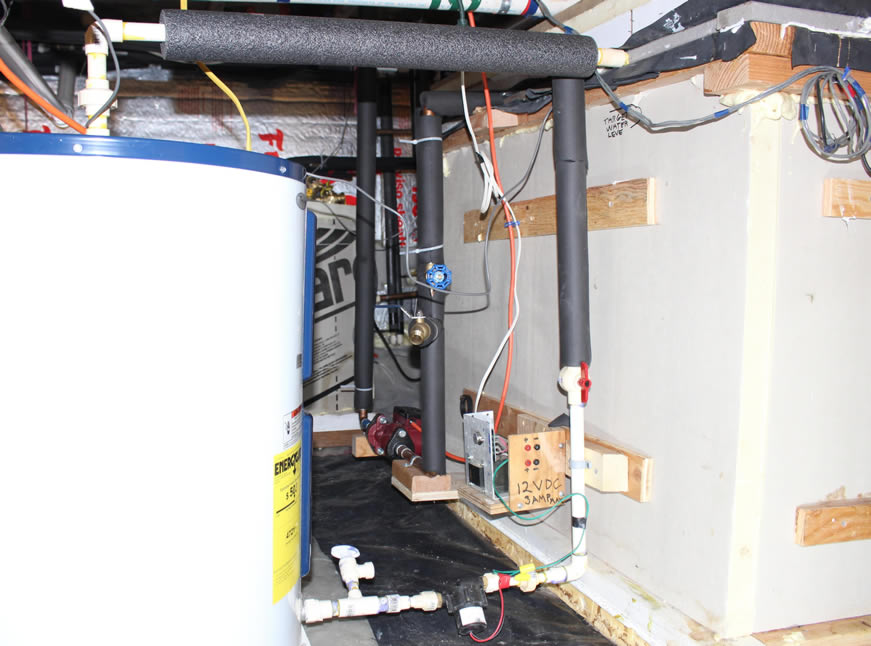
The backup heat electric hot water tank is on the left. The pump is in the lower line -- this line continues into the solar tank and terminates a few inches below the solar tank waterline. So, the pump pumps water from the solar tank into the hot water heater, and this causes water in the hot water heater to flow out the top line and into the solar tank.
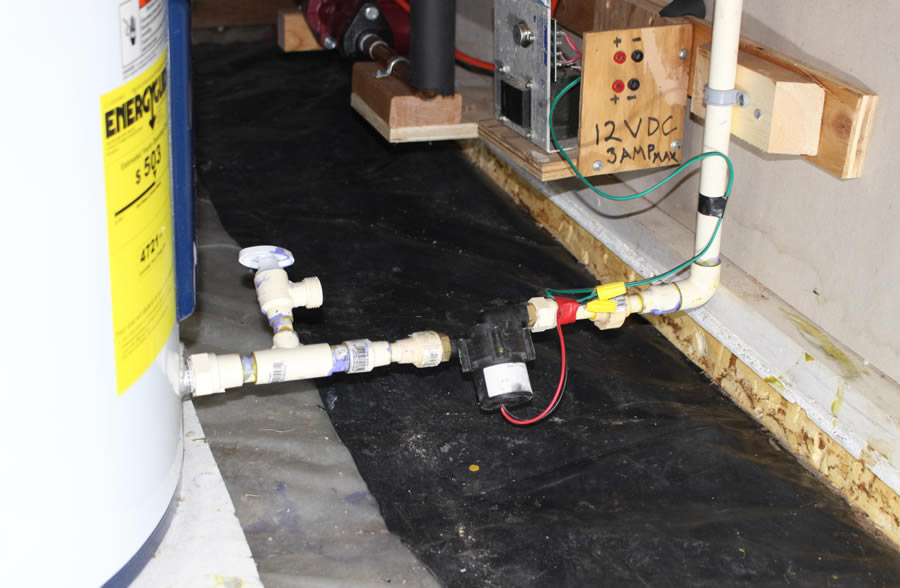
Close up of the TopsFlo pump and its power supply.
Water from the solar tank is circulating right to left and entering the tanks lower drain fitting. The hose bib to the left of the pump is used to fill the hot water tank and the pump plumbing so that the pump has prime when it first starts up.
The TopsFlo pump only draws about 15 watts -- its a brushless DC motor that is supposed to have a long life. I've used a couple of these TopsFlo pumps for various solar applications and have had no problems yet.
The 12 volt power supply is my shop supply and I will replace it with a linear wall wart type of supply.
Controls
The Ranco control shown in the diagram above has a temperature sensor that senses tank temperature. When this temperature drops below the level you set it at, the Ranco powers up the pump and heated water from the electric tank is pumped into the solar tank warming it. When the solar tank gets up to temperature, the Ranco shuts off the pump. The Ranco allows the hysteresis to be set so that you can regulate about how long the pump runs. It typically does not have to run very long to get the solar tank temperature up.
The temperature sensor for the Ranco is tucked in between the EPDM tank liner and the insulation board. This keeps it out of the water.
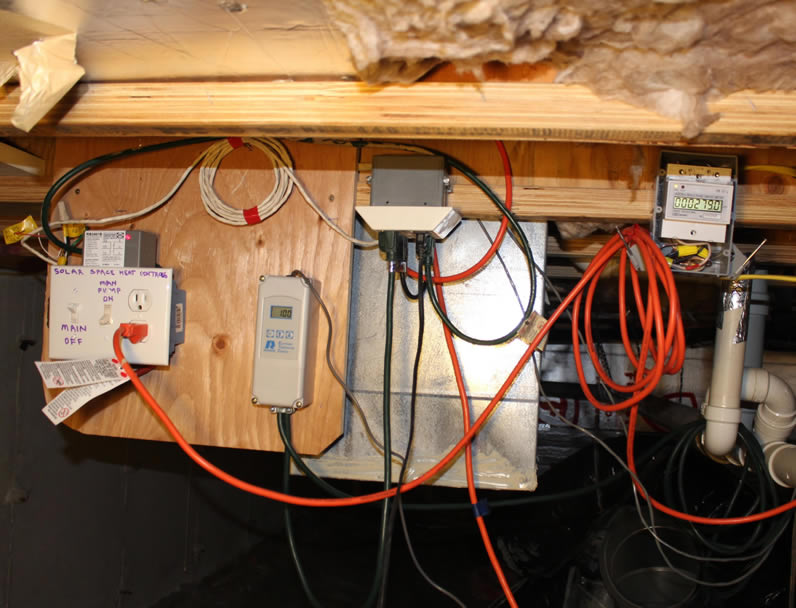
Picture shows the Ranco control (grey tall box) set to not let the solar tank cool below 100F. The white box on the left is the radiant floor heating control. The meter at the upper right (and below) meters the electricity use in KWH for the backup water heater.
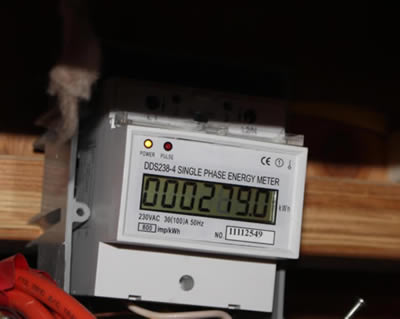
The temperature on the electric hot water heater needs to be set to a value that is somewhat warmer than the temperature set on the Ranco. I currently have the tank set at about 110F and the Ranco set at about 100F. The lower you can keep these temperatures, the more efficiently the solar collectors will operate, but they have to be high enough to provide the heat needed.
Operation
Operation just involves setting the hot water tank to a temperature a bit above the temperature you want to keep as the minimum solar tank temperature. Then the Ranco control is set to the minimum temperature you want the solar tank to maintain.
I have a meter installed on the electric water heater, so I can track how much the backup heat is costing us in electricity. My projection (based on not a lot of data) is that it might come in around 700 KWH for the year. The equivalent propane would only be about 26 gallons, so it appears that this will save us a significant amount of energy compared to running the old gas furnace. So far, the rateof use (after 2 months) has been about 4.6 KWH per day, but this includes a literally record setting two weeks of bitter cold weather.
I had loggers setup to monitor the system for a couple weeks when first went into operation. I will try to do some more extensive logging later in the winter. The general observation so far is that for sunny days, the system requires little to no backup heat. Days with no sun are basically on the backup heater unless there is some heat left over in the tank.
The radiant floor loops, which were designed to be just large enough to use all the solar heat, are somewhat undersized for providing the full heat load on a very cold day. I will likely add some to the floor loops at some point. Another option would be to raise the minimum tank temperature setting, but I'd like to avoid getting this too high as it reduces the solar collector efficiency.
The water heater at 3700 watts has a heating capacity of about 12,600 BTU/hr which is greater than the design heat load for this part of the house. It runs only a small fraction of the time.
Cost
The cost of the new backup system was fairly minimal to me as I had the pump and the Ranco controler already. The electric hot water tank at $280 was the only significant expense. Buying the controller and the pump would have aded about $150. Being able to convert the circuit that the old furnace ran on to a 240VAC circuit also helped to keep cost down.
Other Backup Heat Options
We did consider other alternatives for backup heating:
- A minisplit heat pump would have been efficient, but its fairly expensive and for our cold temperatures, it would have to have had its own backup heat system for the occasional -20F weather. But, it would have been more energy and carbon efficient.
- A heat pump water heater to generate hot water that would have been used to heat the water in the main solar tank. This was appealing for the efficiency and not too awful cost, but I simply could not find a place to put the HPWH where it would have warm enough air to operate in and not be stealing heat from the conditioned space that would just have to be provided by the main gas furnace. To me, this remains a problem with HPWHs -- you really need a place they can get some free heat from, and in the winter in cold climates these spaces don't normally exist.
- An electric immersion heat that would go right in the main solar tank. This is a nice simple and cheap solution, but I did not like the idea of a bare immersion heater operating inside a tank that is made from combustible materials. In the end it seemed simpler just to get an off the shelf electric water heater that is known safe than to try and think through all the guards and fail safes that you would want on a direct immersion heater.
- A flow through inline heater of the type used in hot tubs. This is probably an avenue that I did not pursue as much as I should have. I've since picked up one of these immersion heaters for the right price, and it looks like a pretty good option. It does require a pump to circulate solar tank water through it, and (I suppose) some kind of fail safe to turn the element off if the flow stops and the heater overheats, but it appears to be a compact off the shelf solution that might work OK.
- We did consider just adding electric baseboard for backup heat, but have little wall area where we could locate the baseboard.
- We could have replaced or repaired the gas furnace, but this seems like a very large bill for just to reinstate a heating system that has a lot of disadvantages.
One thing that influences these options is that the cost per delivered BTU for electricity and propane are pretty close here This would not be true if we had cheap natural gas which is available in a lot of places now. The propane is probably somewhat more desirable in terms of CO2 emissions, but I've not seen a CO2 emissions number for propane that includes all the distribution emissions.
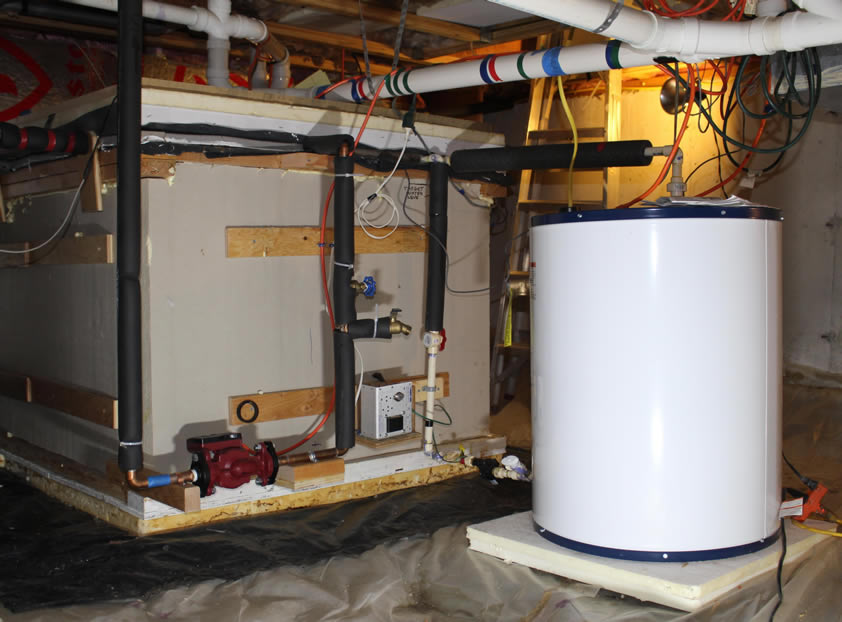
This picture shows the backup heater and main tank from the other side. The Grundfos pump on the left is the floor loop circulation pump.
Gary December 21, 2013







